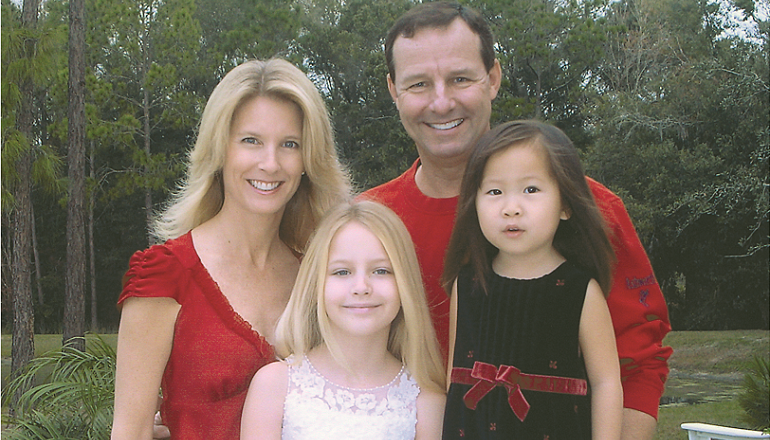Heavy rain drums outside as we crowd into the restaurant foyer, shaking off raindrops. My older daughter, Kathryn, blue-eyed and blonde, stands beside me like a small replica, my genes strung through her like Christmas lights. My younger daughter, a toddler with chocolate brown eyes and a curtain of black hair that swirls out like a skirt, dances at our knees. Her genes are as far-flung as the stars. A woman inches toward us through the throng. She has questions. I know the look.
The woman leans in and asks, in a whisper, "Is she from China?" as she nods toward twirling Hanna.
"Yes," I answer and wait, letting her work up to what she really wants to know.
We're in the process now. She waves her hand toward her husband. "Which agency did you use? When?" This is the adoption version of, "Are you from around here?" I offer the basics, but sense that this woman wants something more. Then she asks it, somewhat sheepishly: "How was the bonding?"
I would take this couple to dinner, tell them everything if I could. I once stalked people in restaurants, clothing stores, airports. I know this is how the deepest information on adoption passes. Yet I do not know how to answer this question. It's not so simple. I know, because it's the question that once haunted me: "Will I love my adopted child the same as the child from my womb?"
Love Takes Time
I couldn't ask just anyone; I needed to find someone like me. Then, one day in a hair salon, I saw her: a freckle-faced strawberry blonde, with a matching older daughter sitting next to her, and an Asian toddler on her lap. After pleasantries, when both girls had wandered out of earshot, I worked my way up to the question: "Do you love her...um....like your own?" She grabbed my flimsy words and filled in the spaces, "Oh, I had that concern, too, don't worry. I love my children exactly the same. It's just another way to have a baby."
I want to give such reassurance to the woman in the restaurant. How was the bonding? Well, it wasn't love at first sight. On a breezy November afternoon, my husband, Kathryn, and I arrived at the orphanage and entered a room lined with polished wooden benches. On one of those benches sat our daughter, the one we would call Hanna. She sat beside her caretaker, playing with her shoes. She looked up as we approached and stared at us with deep, quiet eyes.
Those first months, this was our family's night music: Hanna would scream. My husband would eventually give up and scream at Hanna. I would scream at my husband for screaming at Hanna. Kathryn would cry. Night after night, for months. If I picked Hanna up, she'd wriggle away from me. If I laid her in the crib, she would turn her face to the wall and cry. I remember thinking, I am not the one she wants. I don't look right. I don't smell or sound right. I am not the right mother for her. I would look into those dark eyes and try to be enough. Enough to make up for her sorrow, her loss. How I envied the adoptive mothers who said their children snuggled into their arms on day one and that was that.
The Bond Takes Hold
One night, after Hanna had screamed herself to sleep, she awoke crying. Instead of straining to get away when I picked her up, she nuzzled into me. For a moment, in the dark of an ordinary midnight, we were a mother and a child, with nothing to make up for, no hole to fill.
The next morning, Hanna and I peeked at each other across the room like young lovers. She stacked a block and looked to see if I noticed. I grinned, nodded. She wrinkled her nose, smiled. Our bond had been forged by moonlight in a single moment. When Hanna lurched across the floor toward me, her arms outstretched, a marching penguin in a free-fall into my lap, I gathered her up, along with the answer to bonding with an adopted child. It is not the same as with a biological child. It is no more, nor less, but not the same.
A biological child is first a part of you, and, from the moment of birth, you and she gradually separate. An adopted child is separate at first, moving toward you until you two become one. I would tell the couple in the restaurant this, and that the screaming did end, but right then, the hostess calls our name.
I thrust my card at the woman, tell her to call anytime. She never does. In fact, none of the prospective parents I meet in these encounters ever calls. Come to think of it, I never called anyone either. Seems like the answers are ours to discover in our own sweet time.
JOIN You are viewing this exclusive AF content as a guest. To access our full Adoption Parenting Library — plus digital issues, eBooks, expert audio and more — join Adoptive Families today.  |



